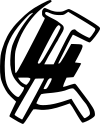
Back Oposició d'esquerra Catalan Levá opozice Czech Venstreoppositionen Danish Linke Opposition in der Sowjetunion German Oposición de izquierda Spanish Vasemmisto-oppositio (Neuvostoliitto) Finnish Opposition de gauche French Oposición de esquerda Galician האופוזיציה השמאלית HE Oposisi Kiri ID
This article has multiple issues. Please help improve it or discuss these issues on the talk page. (Learn how and when to remove these template messages)
|
Left Opposition Левая оппозиция | |
|---|---|
| Leader | Leon Trotsky (de facto) |
| Founded | October 1923 |
| Dissolved | December 1927 |
| Merged into | United Opposition |
| Ideology | Marxism Leninism Trotskyism Anti-Stalinism |
| Political position | Left-wing to far-left |
| National affiliation | Russian Communist Party (Bolsheviks) |
| International affiliation | International Left Opposition |
| Part of a series on |
| Trotskyism |
|---|
 |
The Left Opposition (Russian: Левая оппозиция, romanized: Levaya oppozitsiya) was a faction within the Russian Communist Party (Bolsheviks) from 1923 to 1927[1] headed de facto by Leon Trotsky. The Left Opposition was formed by Trotsky to mount a struggle against the bureaucratic degeneration that began within the party leadership headed by Stalin during the serious illness of the Bolshevik founder Vladimir Lenin. The degeneration intensified after Lenin's death in January 1924.
Intellectuals who had previously lived in exile during the Tsarist era would constitute the core of the Left Opposition during the succession period.[2] Originally, the battle lines were drawn between Trotsky and his supporters who signed The Declaration of 46 in October 1923 on the one hand and a Triumvirate (also known by its Russian name Troika) of Comintern chairman Grigory Zinoviev, Communist Party General Secretary Joseph Stalin and Politburo chairman Lev Kamenev on the other hand.
The Left Opposition argued that the New Economic Policy had weakened the Soviet Union by allowing the private sector to achieve an increasingly important position in the Soviet economy while in their opinion, the centrally planned, socialised sector of the economy languished (including the mostly state-run heavy industries which were seen as essential not only for continued industrialisation but also defence). The platform called for the state to adopt a programme for mass industrialisation and to encourage the mechanization and collectivisation of agriculture, thereby developing the means of production and helping the Soviet Union move towards parity with Western capitalist countries, which would also increase the proportion of the economy which was part of the socialised sector of the economy and definitively shift the Soviet Union towards a socialist mode of production.[3]
There was also the Right Opposition, which was led by the leading party theoretician and Pravda editor Nikolai Bukharin and supported by Sovnarkom Chairman (prime minister) Alexei Rykov and Chairman of the All-Union Central Council of Trade Unions Mikhail Tomsky. In late 1924, as Stalin proposed his new socialism in one country theory, Stalin drew closer to the Right Opposition and his triumvirate with Grigory Zinoviev and Lev Kamenev slowly broke up over the next year (Zinoviev and Kamenev were both executed in 1936). The Right Opposition were allied to Stalin's Centre from late 1924 until their alliance broke up in the years from 1928 to 1930 over strategy towards the kulaks and NEPmen. Trotsky and his supporters in the Left Opposition were joined by the Group of Democratic Centralism to form the United (or Joint) Opposition.
- ^ Daniels, Robert V. (1993). A Documentary History of Communism in Russia (3rd ed.). Burlington, Vermont: University of Vermont Press. pp. 125–129, 158–159. ISBN 978-0-87451-616-6.
- ^ Daniels, Robert V. (1 October 2008). The Rise and Fall of Communism in Russia. Yale University Press. p. 189. ISBN 978-0-300-13493-3.
- ^ Hosking, Geoffrey A. (1993). The first socialist society : a history of the Soviet Union from within (2nd enl. ed.). Cambridge, Mass.: Harvard University Press. pp. 137–138. ISBN 0674304438. OCLC 26851510.
© MMXXIII Rich X Search. We shall prevail. All rights reserved. Rich X Search